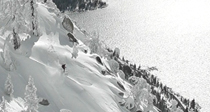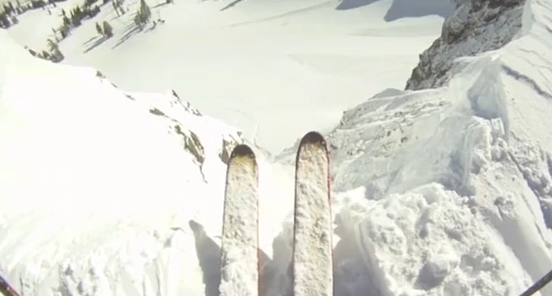By Rob McCormick
Fifteen years ago 90% of my ski days were at ski areas and 10% were in the backcountry. Today 90% of my days are in the backcountry and 10% are at ski areas. Having been on the same touring setup since 2006, I decided I needed to upgrade. My primary motivation was to get something stable and floaty in powder yet versatile enough for all conditions. I wanted a setup that would inspire me for multiple laps when touring and allow me to handle long approaches and big vertical involved with ski mountaineering. I am not a techy guy who spends hours studying product specs and reviews so I spoke with a few friends who tour and the Dynafit name kept popping up. My wife made good on her Christmas present offer of new touring gear by picking up the Stoke ski, the TLT Vertical binding and custom Dynafit skins at the BackCountry in Truckee. I was not disappointed.
The first thing I noticed when I clicked in was the weight, or lack there of. It felt like I had nothing on my feet. The bindings are very minimalistic in design which is durable and practical, but has nothing extra to add weight. The range of motion on the bindings is unbelievable. They pivot so far forward you can literally kneel on the fronts of your skis. This allows for much less wasted effort when skinning. The heelpiece can be adjusted by rotating to different heights depending on the slope you are climbing. The toepiece has two pins that lock into each side of the front of the ski boot. I have the Garmont Radium boot which is Dynafit compatible. Many companies now make boots that are compatible with the Dynafit binding which says something about the direction they think skiers are headed with touring bindings.
The custom precut speedskins are awesome because you don’t have to measure, stencil and cut the skins manually. More importantly, they provide great traction when climbing. The adhesive sides are way more user friendly than my past skins that I had to battle to pull apart at the bottom of every run. The skins have a unique rubber pulltab that integrates perfectly with the metal tips of the Stokes. Combined with the tremendous forward range of the bindings, the tab allows you to easily remove the skins while the skis are still on your feet. I didn’t think I would be able to do it but was pulling it off my first day without taking my skis off at the top. This feature is especially handy since the one drawback to the bindings is the four point attachment system can be tricky to engage at first. It is essential to bring a pointed tool or something you can use to clear ice and snow from the bindings and/or boot pin holes to allow them to engage properly.
Now for the fun part…the skis! The Stokes are amazing! The core is made of bamboo and beech which keeps it very light for climbing. A slightly rockered tip keeps it from diving in pow. The ski handles dreamy at speed yet turns when it needs to. I didn’t think I could get freeride performance and stability out of something so light yet the Stoke does it with authority. It’s only 106 cm underfoot but I found it well suited for climbing up and out of deep snow when setting a track and the perfect dimensions for shredding the backcountry. My wife got me these things for riding pow and it looks like she hit the bullseye.
OK enough chitchat from a non techhead who doesn’t really know much about gear but knows what he likes to ski. Here’s POV footage of my first legit backcountry run on the Stoke. The skier I am following is Jason Mack who is also on the Dynafit binding setup.




Recent Comments